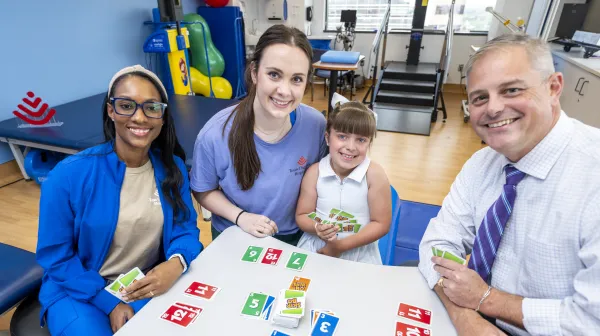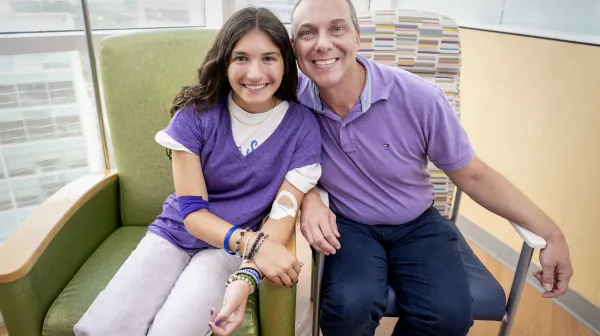When you see 4-year-olds Phee and Cubby, two identical, joyful, curious girls, you would hardly believe they were given just a 10% chance of being born.
Right from the start, the odds of pregnancy were already stacked against RJ and Bunny, the twin’s parents, so they elected to pursue in vitro fertilization.
“Just three days after our first cycle of in vitro, a blood test confirmed we were pregnant. Twelve days later, we had an ultrasound and the physician said she saw a dot on the screen, but I told my wife, I thought I saw two in there. She laughed and dismissed it,” RJ recalled.
It turns out RJ was right. Another ultrasound about two weeks later confirmed Bunny was carrying not one, but two babies.
“Right away they sent us to see a high-risk expert at our home town in Charleston, South Carolina where we were monitored weekly,” RJ remembered.
Everything was going smoothly until about 12 weeks in, when RJ and Bunny received a shocking report.
“We were in the hospital for our usual appointment and the doctor told us my wife was displaying symptoms of twin-to-twin transfusion syndrome,” RJ said.
Also known as TTTS, this serious condition occurs in approximately 10% to 15% of pregnancies with identical twins that share one placenta. Blood vessel connections within the placenta allow the fetuses to share blood supply and can cause an imbalance in the fetal blood volumes. As a result of unequal blood flow, one twin (the donor twin) pumps blood to the other twin (recipient twin). The condition can cause the recipient twin to produce too much amniotic fluid (polyhydramnios) and ultimately cause fetal heart failure due to over volume of blood.
There are five stages of TTTS. At Bunny’s 16-week appointment, her doctor discovered her disease had progressed from stage I to stage II, increasing the urgency to seek medical intervention.
“Our doctor told us we needed to be in Houston as soon as possible; so, we got up at five the next morning and headed to Houston, desperate to find help,” RJ said.
The family met with Dr. Shamshirsaz (Shami), chief of fetal therapy and surgery at the Pavilion for Women. The care team decided it was best to closely monitor up to 18 weeks because outcomes of fetal intervention will be better. The procedure will be laser ablation of placenta anastomoses which stop sharing of blood between babies.
“So, we began to wait anxiously. We got ultrasounds every two days and when the girls were exactly 17 weeks along, we had our usual 8 a.m. ultrasound. Within 5 to 10 minutes the entire team filled the room. I knew something was wrong,” RJ remembered.
The scan showed a quick progression of the disease necessitating a more hastened decision. This was difficult to make though because, ideally, laser ablations would occur after mom reaches 18 weeks gestation.
The family decided to have the surgery and by noon Bunny was in the operating room. The surgery was performed by Dr. Espinoza, another fetal surgeon at the Pavilion for Women. It was higher risk of intervention at 17 weeks. The first 48 hours were critical as sudden hemodynamic changes in a very young and fragile babies.
Bunny recovered surprisingly well from the fetal intervention and returned to Charleston after spending just three days at the hospital following the procedure. The Pavilion for Women care team worked closely with the team of doctors in Charleston to continue Bunny’s care at her hospital in Charleston. She was placed on modified bed rest and experienced preterm labor twice during the rest of her pregnancy.
"That was scary, I’d never felt the sense of fear, or worry, until that day when it really hit me. I started to wonder how we went from doing really well to the possibility of losing one, or maybe even both girls,” RJ lamented.

Bunny pulled through and at 31 weeks and 3 days, she delivered both girls, healthy though they were small.
“The girls came out a little over 3 lbs. each. They were just teeny-tiny. I Could hold them both in one hand,” RJ recalled.
They spent three weeks in the NICU and went home at over 4 lbs. each.
“We had to go buy new car seats before leaving the hospital because they were so little.”
Now, 4 years have passed and the twins, Josephine (Phee) and Clifton (Cubby), are both thriving.
“When we brought them home, the two of them could fit in one boppy pillow together and now they are in their big girl beds and started preschool. They are both into ballet, love horses, love to swim and enjoy going to the beach. It’s amazing, really,” RJ said with excitement.
Phee, the oldest twin is very friendly and outgoing. Although she does not have any usable digits on her right hand, she is unstoppable and is usually the first to try anything!
“Cubby is the thinker; her memory is phenomenal. Since they both have a built-in play partner, when we go to new places, they go right in and we are definitely thankful for that,” RJ said proudly.
Looking back now after such a difficult diagnosis, RJ wants to encourage families going through the same to think about hope.
“I want other families to think about hope. Life is challenging even for a healthy person as opposed to anyone diagnosed with an ailment. We don’t know what God’s will is for our life or for this particular issue. Hope you can see the good – whatever the outcome, even if it’s not your ideal. Learn something from your journey. For us, we are so thankful for the people we met who helped us along the way,” RJ said.

Photos courtesy of RJ


